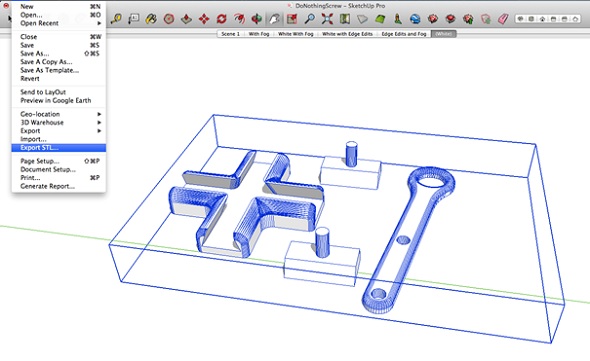

- #EXPORT IMAGES FROM SKETCHUP ONLINE HOW TO#
- #EXPORT IMAGES FROM SKETCHUP ONLINE INSTALL#
- #EXPORT IMAGES FROM SKETCHUP ONLINE SOFTWARE#
- #EXPORT IMAGES FROM SKETCHUP ONLINE PROFESSIONAL#
- #EXPORT IMAGES FROM SKETCHUP ONLINE DOWNLOAD#
If you have SketchUp Pro: You’ll be able to export the lines to many different formats.

If you are not worried about using the finished contours at a certain scale, then skip to step 4, if not, see one of two options below.Ī. Move the copied rectangle the distance you decided on before for the space between contours. Then while the move tool is selected, hit the control/command key to enable a copy of the selection. You’ll now draw a rectangle to define the area in which the contours area generated. Move the four pins around until you have your desired selection, and click on grab area.ģ. Locate the area you want, and then click on select region. Open up SketchUp and click on the add imagery icon. Follow the steps below to find out how.ġ.
#EXPORT IMAGES FROM SKETCHUP ONLINE DOWNLOAD#
If you don’t have the time or knowledge to search for and download contour lines from online GIS or topographic data sources, there’s a relatively quick and simple way to generate contour lines in SketchUp from imported Google Earth Terrain.
#EXPORT IMAGES FROM SKETCHUP ONLINE HOW TO#
In future Instructables, we will introduce you to the basics of SketchUp modelling and lead you through step-by-step in creating your first 3D printable 3D model.įollow on Facebook here or on Twitter here.This tutorial will show you how to create contour lines from terrain in SketchUp But we have used SketchUp to design 3D printed items such as laboratory equipment, automatic fish feeders, and custom project cases for IoT systems and voltage regulators for solar powered projects. Whether you are printing scale models, spare parts, or prototypes for product design, SketchUp allows you to quickly design and redesign models that can then be printed out right before your eyes.įor our 2-3 hour-long workshops, we usually have students design something simple like a keychain. By the time you do decide to move on to a more complex 3D design suite, you will be an experienced designer who will likely pick up another program very quickly.Īnd because it is so widely used and easy to learn it is probably a good thing that it is also very apt at modeling for 3D printing. You can take SketchUp as far as you want to without worrying about running into many limitations.
#EXPORT IMAGES FROM SKETCHUP ONLINE PROFESSIONAL#
It is so simple, children can learn it thanks to its many intuitive tools.Įveryone from students and hobbyists to professional designers and engineers use it everyday all over the world. SketchUp is a 3D design program free to download with a large user community and an ever-growing number of plug-ins that make it useful for designers, engineers, artists, and the curious alike. If you have any trouble doing any of this - please join our Facebook 3D design and 3D printing group and feel free to ask us for help. You can also use programs like NetFabb Basic to automatically repair STL files (we'll cover that in a future Instructable). If you see something strange, you will need to go back to your 3D model in SketchUp and see what you can change geometry-wise to simplify and clean up your model. This is an important step because sometimes what the normal view shows is not what your printer ends up printing due to format issues with some STL files. This will show you exactly what your 3D printer will print. TIP: When you drop your STL into your 3D slicer program, make sure to ALWAYS! check it in layer view. If you don't have a 3D printer, this STL file is what you will pass on to your local makerspace or friend to print for you.

#EXPORT IMAGES FROM SKETCHUP ONLINE SOFTWARE#
Using an STL file for 3D printing: Usually if you are using Cura or MakerBot Desktop software you can just drag the STL file from Windows Explorer into the workspace and then prepare it to print.

#EXPORT IMAGES FROM SKETCHUP ONLINE INSTALL#
If you cannot install the plugin inside of SketchUp:


 0 kommentar(er)
0 kommentar(er)
